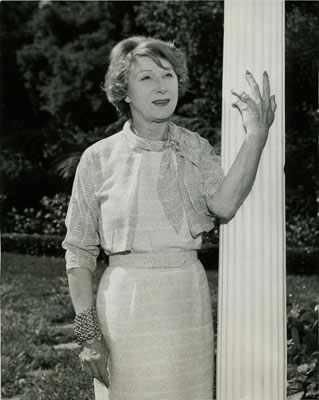‘How long did the famous actress Judith Anderson live here?’
-Nyletta Robinson

Dame Judith Anderson died at her Montecito home at the age of 94 in 1992. She had first come to Santa Barbara in 1929 to appear in the play Strange Interlude. In 1946, she married her second husband, Luther Greene, a theatrical producer and a rancher in the Carpinteria Valley. Shortly thereafter, they purchased a ranch in the foothills overlooking the valley. Although the couple divorced in 1951, the South Coast would become home to Anderson for more than 40 years.
She was born in Adelaide, Australia, in 1897 and from the beginning evidenced a strong interest in performing. Admittedly not the best of students, she did win a number of medals in drama competitions as a youngster. In 1918, she and her mother made the long journey to New York City. It was a struggle at first, with her mother taking jobs as a seamstress while Anderson made the rounds of the booking agents, until getting her first significant role with the Emma Bunting Stock Company at the 14th Street Theatre. She also worked in stock companies in Boston, Albany, and Schenectady, New York, which she credited with giving her wonderful experience and in aiding her versatility on stage. It was during this period that a producer suggested she change her name from Frances Margaret to the more “dramatic” Judith.
Anderson became best-known for her classical roles. She played in Macbeth with both Maurice Evans and Laurence Olivier and played opposite John Gielgud in Hamlet. She won two Emmy awards for her television performances as Lady Macbeth, the first in 1954 and the second in 1960. It was a role she had first played back in the 1920s.
In 1948, she appeared in what was arguably her most famous role, that of Medea, in a special play adaptation of the Greek myth penned by poet Robinson Jeffers, who was a good friend of hers. She won a Tony Award for that performance. She later played the role of the nurse in Medea, which earned her a Tony nomination in 1982.
Anderson first appeared in films in 1933 and built a solid movie career as a character actress. Probably her most famous film role was that of the mean-spirited housekeeper, Mrs. Danvers, in the 1940 film Rebecca, with Laurence Olivier and directed by Alfred Hitchcock, for which she was nominated for an Oscar for best supporting actress. She played in Kings Row, starring Ronald Reagan, in Laura in 1944, and 1958’s Cat on a Hot Tin Roof. She also appeared in Cecil B. DeÂ-Mille’s epic, The Ten Commandments.
Locally, Anderson performed at the Lobero Theatre any number of times. Following Strange Interlude in 1929, she returned in Mourning Becomes Electra in 1932. In 1970, the Lobero staged the world premiere of Anderson playing Hamlet, before the production opened in New York’s Carnegie Hall. Yet another local connection was her appearance, from 1984 to 1987, in the TV soap opera Santa Barbara, in which she appeared as the formidable Minx Lockridge.
Anderson was also a great community benefactor. The Dame Judith Anderson Fund was established to promote theater in Santa Barbara and to fund renovations to the Lobero Theatre. She gave readings to benefit the Ensemble Theatre, including works by Shakespeare and her good friend Jeffers. She could be found at Las Positas Park reading nursery rhymes and stories to children to benefit Family Service Agency. With her far-ranging connections in the world of theater and entertainment, she often was instrumental in using her influence to get celebrities to lend their support to various Santa Barbara causes.
At her death, Dame Judith Anderson was eulogized as the grand dame of both the theater and, in another sense, of Santa Barbara. Her portrait still hangs in the foyer of the Lobero Theatre where she had performed so many times and which she had nurtured for so many years.



